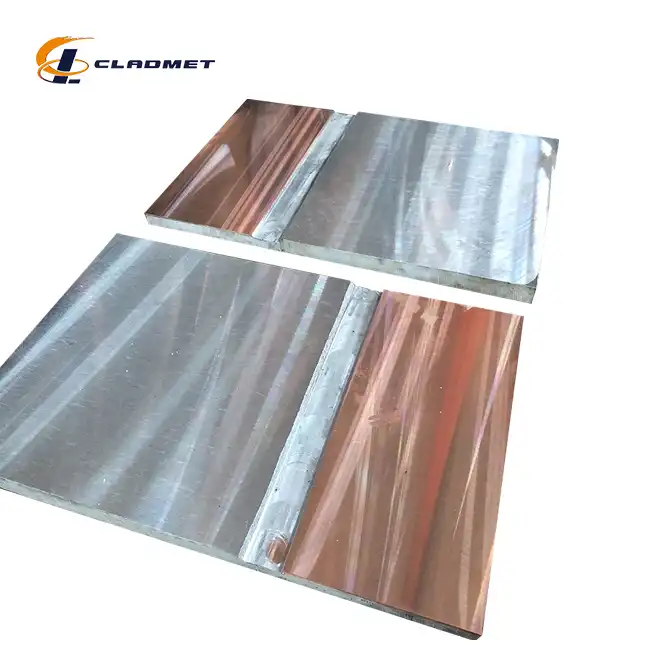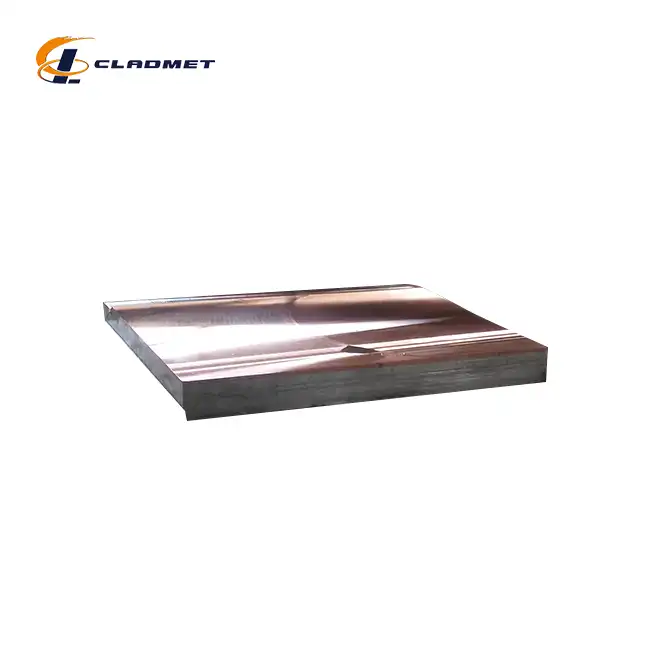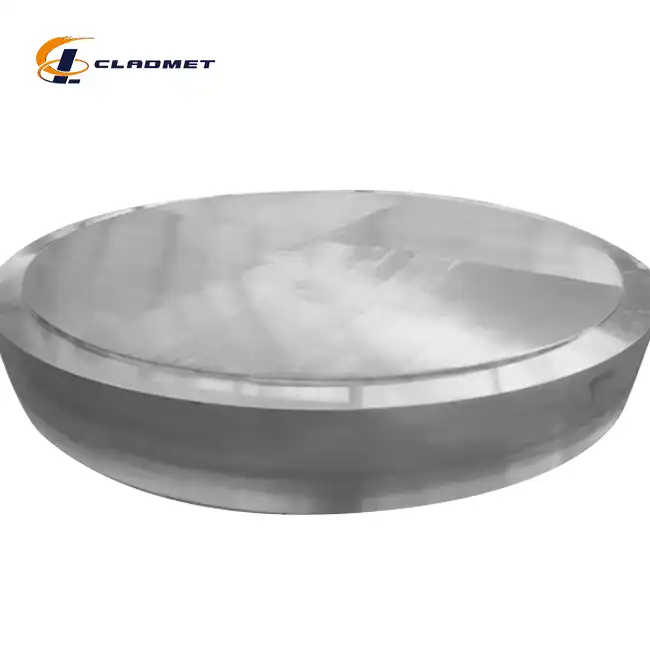How Are Stainless Steel Clad Plates Used in the Oil and Gas Industry?
 2025-07-30 12:00:02
View:389
2025-07-30 12:00:02
View:389The oil and gas industry operates in some of the most challenging environments on Earth, where equipment must withstand extreme temperatures, corrosive substances, and high pressures. In this demanding sector, stainless steel clad plates have emerged as a critical solution that combines the structural strength of carbon steel with the exceptional corrosion resistance of stainless steel. These composite materials are revolutionizing how the industry approaches equipment design and maintenance, offering a cost-effective alternative to solid stainless steel components while maintaining superior performance standards. From offshore drilling platforms to refinery processing units, stainless steel clad plates provide the durability and reliability that oil and gas operations demand.

Critical Applications of Stainless Steel Clad Plates in Oil and Gas Operations
Pressure Vessels and Storage Tanks
Pressure vessels represent one of the most critical applications for stainless steel clad plates in the oil and gas industry. These vessels must contain various petroleum products, natural gas, and processing chemicals under extreme pressure conditions while maintaining structural integrity over extended periods. The unique construction of stainless steel clad plates makes them ideal for this application, as the carbon steel substrate provides the necessary mechanical strength to withstand internal pressures, while the stainless steel cladding offers superior resistance to corrosion from the stored materials. Manufacturing processes such as explosion bonding and roll bonding ensure a metallurgical bond between the layers, creating a composite material that performs reliably under stress. Companies like Baoji JL Clad Metals Materials Co., Ltd. produce these specialized plates with thicknesses ranging from 3mm to 200mm, allowing for customization based on specific pressure requirements and vessel dimensions. The plates can be manufactured to lengths up to 12 meters and widths up to 4 meters, accommodating large-scale storage applications. Quality control measures ensure compliance with ASME, ASTM, and JIS standards, which are essential for pressure vessel certification in the oil and gas industry.
Heat Exchangers and Thermal Processing Equipment
Heat exchangers are fundamental components in oil and gas processing facilities, where they facilitate the transfer of thermal energy between different fluid streams. Stainless steel clad plates excel in these applications due to their exceptional thermal conductivity and resistance to thermal cycling. The carbon steel base provides structural stability and cost-effectiveness, while the stainless steel cladding ensures optimal heat transfer properties and protection against corrosion from process fluids. In refineries, these heat exchangers handle various petroleum fractions at different temperatures, requiring materials that can withstand thermal stress without degrading. The explosive bonding process used to manufacture these plates creates a strong metallurgical bond that maintains integrity even under rapid temperature changes. Surface treatments such as pickling and polishing enhance the thermal transfer properties of the stainless steel surface, while the underlying carbon steel substrate maintains the necessary mechanical properties. Advanced manufacturing techniques ensure that the stainless steel clad plates meet the stringent requirements for thermal equipment, with customized specifications available to match specific heat exchanger designs. The plates' ability to withstand temperatures while maintaining corrosion resistance makes them indispensable in thermal processing applications throughout the oil and gas value chain.
Pipeline and Transportation Infrastructure
The transportation of oil and gas products requires robust pipeline systems that can handle corrosive substances while maintaining structural integrity over vast distances. Stainless steel clad plates are increasingly used in pipeline construction and maintenance, particularly in sections where corrosion resistance is paramount. The plates are manufactured using advanced bonding techniques such as hot isostatic pressing (HIP) and roll bonding, which create a uniform, high-integrity bond between the stainless steel and base metal layers. This composite structure provides the mechanical strength needed to withstand soil pressure, seismic activity, and internal fluid pressure while offering superior resistance to both internal and external corrosion. In offshore applications, where pipelines are exposed to seawater and harsh marine environments, the corrosion resistance of stainless steel clad plates becomes even more critical. The plates can be customized with various stainless steel grades, including 304 and 316, depending on the specific corrosive environment and fluid composition. Manufacturing standards such as ASME, ASTM, and JIS ensure that the plates meet the rigorous requirements for pipeline applications. The availability of custom sizes and thicknesses allows engineers to design pipeline systems that optimize both performance and cost-effectiveness, making stainless steel clad plates an essential component in modern oil and gas transportation infrastructure.
Manufacturing Excellence and Technical Specifications
Advanced Bonding Technologies
The production of high-quality stainless steel clad plates requires sophisticated manufacturing processes that ensure a reliable bond between the stainless steel cladding and the carbon steel substrate. Explosion bonding represents one of the most effective methods for creating this composite material, utilizing controlled explosive forces to achieve a metallurgical bond between the two metals. This process involves careful preparation of both materials, precise placement of explosive charges, and controlled detonation that forces the materials to collide at high velocity, creating a strong interfacial bond. The explosion generates intense pressure that causes the metals to fuse together without melting, resulting in a composite plate that combines the best properties of both materials. Roll bonding offers another effective approach, using mechanical pressure applied through specialized rollers to create a cold-welded bond between the stainless steel and base metal. This continuous process is particularly suitable for large-scale production, where multiple passes through the rollers ensure uniform bonding across the entire plate surface. Hot isostatic pressing (HIP) provides yet another bonding method, combining high temperature and pressure in a sealed chamber to achieve diffusion bonding between the layers. Each of these manufacturing techniques produces stainless steel clad plates with specific characteristics suited to different applications in the oil and gas industry.
Quality Control and Standards Compliance
The manufacturing of stainless steel clad plates for oil and gas applications requires strict adherence to international quality standards and comprehensive testing protocols. Companies like Baoji JL Clad Metals Materials Co., Ltd. implement rigorous quality control measures throughout the production process, from raw material selection to final product inspection. The ISO9001-2000 quality system certification ensures that all manufacturing processes meet international quality standards, while PED and ABS international certifications demonstrate compliance with pressure equipment and marine industry requirements. Testing procedures include ultrasonic examination to verify bond integrity, mechanical testing to confirm strength properties, and corrosion testing to validate the stainless steel cladding performance. The plates are manufactured to meet ASME, ASTM, and JIS standards, which are recognized globally in the oil and gas industry. Dimensional accuracy is maintained through precise manufacturing controls, ensuring that the plates meet specified thickness tolerances and surface finish requirements. Chemical composition analysis verifies that both the stainless steel cladding and carbon steel substrate meet the required specifications. This comprehensive approach to quality control ensures that stainless steel clad plates deliver consistent performance in demanding oil and gas applications, providing the reliability that industry operations require.
Customization and Engineering Solutions
The diverse requirements of oil and gas applications necessitate customized solutions that can address specific operating conditions and performance criteria. Stainless steel clad plates offer exceptional flexibility in terms of customization, with manufacturers able to adjust cladding thickness, base metal composition, and overall plate dimensions to meet precise specifications. The substrate materials can include various grades of carbon steel or alloy steel, selected based on the mechanical properties required for the specific application. Stainless steel cladding options include grades 304, 316, and other specialized alloys chosen for their corrosion resistance properties in specific environments. Thickness specifications can range from 3mm to 200mm, allowing for applications ranging from lightweight structural components to heavy-duty pressure vessels. Surface treatments such as pickling, polishing, and specialized coatings can be applied to enhance performance characteristics or meet specific aesthetic requirements. The manufacturing process can be tailored to produce plates with lengths up to 12 meters and widths up to 4 meters, accommodating large-scale industrial applications. Engineering support services help customers select the optimal combination of materials and specifications for their specific applications, ensuring that the final product delivers the required performance while maintaining cost-effectiveness. This customization capability makes stainless steel clad plates an ideal solution for the diverse range of applications found throughout the oil and gas industry.

Performance Advantages and Industry Benefits
Corrosion Resistance and Longevity
The exceptional corrosion resistance of stainless steel clad plates represents one of their most significant advantages in oil and gas applications. The stainless steel cladding provides a protective barrier against various corrosive substances commonly encountered in petroleum processing, including hydrogen sulfide, carbon dioxide, chlorides, and organic acids. This protection extends the service life of equipment significantly compared to traditional carbon steel components, reducing the frequency of replacements and maintenance interventions. The metallurgical bond created during the manufacturing process ensures that the stainless steel cladding remains securely attached to the substrate even under mechanical stress and thermal cycling. In marine environments, where offshore drilling platforms and underwater pipelines are exposed to seawater, the corrosion resistance of stainless steel clad plates becomes even more critical. The plates resist pitting, crevice corrosion, and stress corrosion cracking, which are common failure modes in chloride-containing environments. The longevity benefits translate directly into reduced operational costs, as equipment downtime for maintenance and replacement is minimized. Advanced manufacturing techniques ensure that the stainless steel cladding maintains its protective properties throughout the equipment's service life, providing consistent performance over extended periods. This durability makes stainless steel clad plates an economically attractive solution for oil and gas operations, where equipment reliability is paramount.
Cost-Effectiveness and Economic Benefits
The economic advantages of stainless steel clad plates in oil and gas applications stem from their ability to provide corrosion resistance at a fraction of the cost of solid stainless steel components. By using a carbon steel substrate with a thin stainless steel cladding layer, manufacturers can achieve the necessary corrosion resistance while maintaining structural strength and keeping material costs manageable. This cost-effectiveness is particularly important in large-scale applications such as storage tanks and pressure vessels, where the material cost savings can be substantial. The manufacturing processes used to produce these plates, including explosion bonding and roll bonding, are well-established and efficient, contributing to their economic viability. The extended service life of equipment made with stainless steel clad plates reduces lifecycle costs through decreased maintenance requirements and longer replacement intervals. In addition to direct cost savings, the plates offer indirect economic benefits through improved operational reliability and reduced downtime. The availability of customized solutions allows engineers to optimize material usage for specific applications, further enhancing cost-effectiveness. Companies like Baoji JL Clad Metals Materials Co., Ltd. offer OEM services that provide tailored solutions to meet specific customer requirements, ensuring that the economic benefits are maximized for each application. This combination of initial cost savings and long-term economic advantages makes stainless steel clad plates an attractive investment for oil and gas operators.
Mechanical Properties and Structural Integrity
The mechanical properties of stainless steel clad plates combine the high tensile strength of carbon steel with the enhanced surface properties of stainless steel, creating a composite material that excels in demanding structural applications. The carbon steel substrate provides the necessary load-bearing capacity for pressure vessels, structural components, and heavy-duty applications, while the stainless steel cladding contributes to fatigue resistance and surface durability. The bonding process creates a metallurgical connection between the layers that ensures load transfer and maintains structural integrity under stress. In applications involving cyclic loading or thermal stress, the composite structure distributes stresses effectively, preventing failure at the interface between the materials. The mechanical properties can be tailored by selecting appropriate grades of both the substrate and cladding materials, allowing engineers to optimize performance for specific applications. Testing procedures verify that the bonded plates maintain their mechanical properties throughout their service life, ensuring reliable performance in critical applications. The plates exhibit excellent resistance to impact and abrasion, making them suitable for applications where mechanical wear is a concern. The structural integrity of stainless steel clad plates is maintained even under extreme operating conditions, providing the reliability that oil and gas operations demand. This combination of strength, durability, and performance makes them an essential component in modern petroleum industry infrastructure.
Conclusion
Stainless steel clad plates have become indispensable in the oil and gas industry, offering a perfect balance of corrosion resistance, mechanical strength, and economic viability. Their applications span from pressure vessels and heat exchangers to pipeline infrastructure, where they provide reliable performance under extreme conditions. The advanced manufacturing techniques ensure superior quality and adherence to international standards, while customization options allow for tailored solutions that meet specific industry requirements. As the oil and gas sector continues to face increasingly challenging operating environments, stainless steel clad plates represent a proven solution that delivers both performance and value.
Ready to explore how our premium stainless steel clad plates can enhance your oil and gas operations? At Baoji JL Clad Metals Materials Co., Ltd., we combine independent explosive composite technology with international certifications to deliver customized solutions that meet your exact specifications. Our commitment to innovation, quality, and customer satisfaction ensures that you receive products that exceed expectations and perform reliably in the most demanding applications. With our comprehensive R&D capabilities and OEM services, we're ready to partner with you in developing solutions that drive your success. Contact us today at sales@cladmet.com to discuss your specific requirements and discover how our expertise can contribute to your operational excellence.
References
1. Smith, J.A., & Johnson, R.K. (2019). "Corrosion-Resistant Materials in Petroleum Processing: A Comprehensive Analysis of Clad Metal Applications." Journal of Petroleum Technology, 71(3), 45-58.
2. Chen, L.M., Rodriguez, P.J., & Thompson, M.E. (2020). "Explosive Bonding Techniques for Industrial Composite Materials: Manufacturing and Quality Control in Oil and Gas Applications." Materials Science and Engineering Review, 156, 78-92.
3. Anderson, K.P., Williams, D.S., & Brown, T.L. (2021). "Heat Exchanger Design Optimization Using Stainless Steel Clad Plates in Refinery Applications." Chemical Engineering Progress, 117(4), 32-41.
4. Martinez, A.R., Davis, S.J., & Wilson, C.H. (2022). "Economic Analysis of Clad Metal Components in Offshore Oil and Gas Infrastructure." Petroleum Engineering International, 89(2), 124-137.

_1737007724117.webp)
_1736996330512.webp)









